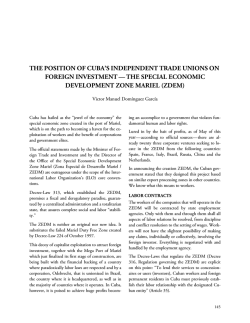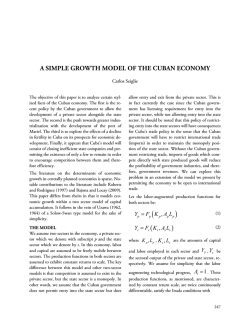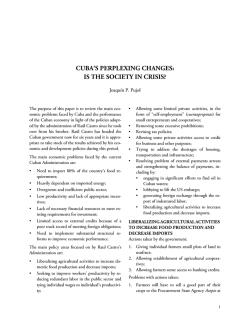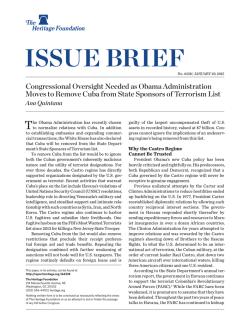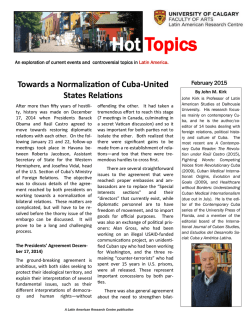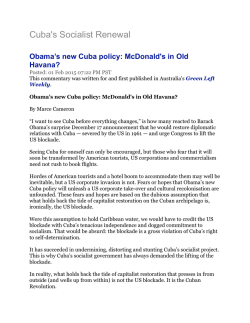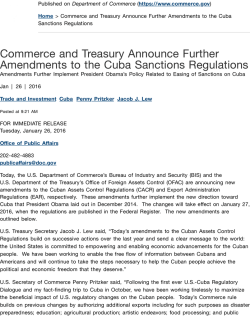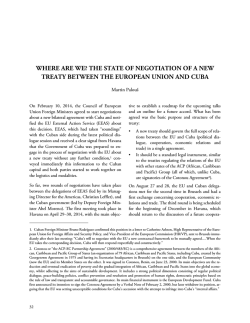
Assessment of the Cuban Marketplace
Special report Assessment of the Cuban marketplace | June 2015 Navigating the uncharted waters of doing business in Cuba The Cuban marketplace and potential Cuba is the largest island in terms of land mass and most populated country in the Caribbean. The country is home to 11.2 million residents, of which nearly 20.0 percent live in the capital of Havana, making it the country’s largest city. According to the Office of National Statistics in Cuba, population growth in Cuba has remained relatively flat since 2005, losing roughly -0.1 percent of its resident base per year. Projected population decline is expected to continue into 2020, decreasing by 1.1 percent to 11.1 million. Although these projections were compiled before the announcement, it remains more probable than not that births and deaths will stay relatively in line given the country’s population base (discussed further below). For any significant population growth to occur, a large uptick in in-migration would be needed; however, until wholesale changes are made to Cuba’s political and economic system any significant increase in new residents to the island is unlikely. Cuban population figures are also weak when compared to other developing economies. Currently, residents over 65 years of age comprise 13.5 percent of the island’s population. For comparison, that cohort comprises only 7.6 percent in Brazil, 7.0 percent in the Dominican Republic, and just 5.8 percent in India. To offer further perspective, the senior citizen population of the United States, a fully mature and established economy, makes up 14.5 percent of the overall population. Meanwhile, on the other end of the cycle, only 16.3 percent of the country’s population is under the age of 14. This composition is markedly different from other expanding economies and current demographic projections do not present the case for economic expansion. This is a contributing factor to the push for economic reforms from within the Cuban government and its attempts at attracting foreign investment (discussed further below). Average annual population growth rate 1.0 0.5 Growth rate (%) Opportunistic investors are intrigued by the amendments to the U.S.Cuba economic embargo announced at the close of 2014. After more than five decades, restrictions under the Trading with the Enemy Act have been “relaxed” by what has been dubbed the Cuban Thaw. Yet this prospect of new opportunity has left many unknowns. How will the establishment of business relationships with Cuban entities and a communist political system be implemented? Are the potential economic gains worth the risk and stress of navigating unclear regulatory burdens and legal stipulations? We explore these concerns herein by first assessing the current market conditions and evaluating past indicators for viable business opportunities. We will also investigate future potential due to regulatory changes and outline possible challenges of engaging with a once forbidden economy. Understanding these fundamentals will be key to determining the financial viability of entering the Cuban market. 0.0 -0.5 -1.0 -1.5 -2.0 2005 2006 2007 2008 2009 2010 2011 2012 2013 The Cuban government is also hungry for foreign investment to bring about quality employment opportunities. Cuba boasts one of Latin America’s most skilled and highest educated labor forces. Despite a near 100 percent literacy rate, 41.0 percent of the workforce is employed in the “community, social and personal services” sector, which has an average annual wage in Cuban Pesos equivalent to US$220, a figure that has increased only 2.6 percent annually since 2008. To put the economic scale of Cuba in perspective, the country’s GDP is $68.2 billion, slightly higher than that of Sri Lanka, and just below that of the state of New Hampshire. However, unlike New Hampshire, the lack of access to goods and services in Cuba makes it incredibly difficult to afford items beyond basic needs. Goods that have reached near saturation in the United States such as internet access or high-tech equipment are considered opulent in Cuba. Current infrastructure Cuba encompasses 42,400 square miles and is the most connected island in the Caribbean. The country boasts over 5,000 miles of railroad tracks and 37,800 miles of roadways, of which just under half are paved. Despite the vast web of transportation routes traversing the island, much of this infrastructure has fallen into disrepair after years of neglect from the Cuban government, which is another contributing factor in the country’s efforts to attract foreign investment. One of the largest infrastructure projects that came to fruition with the aid of foreign entities was the Port of Mariel, located roughly 30 miles from Havana. Cuba’s infrastructure at a glance Airports with paved runways 64 Railways 5,097 miles Standard gauge 5,054 miles Narrow gauge 43 miles Roadways 37,815 miles Paved 18,259 miles Unpaved 19,286 miles Ports and terminals 8 The Port recently underwent an extensive $1.0 billion renovation, led primarily by the Brazilian construction and engineering firm Odebrecht, which is currently completing renovations at Miami International Airport. The project, which was completed in early 2014, included the deepening of the shipping channel to accommodate Post-Panamax vessels, new gantry cranes, and increased container capacity to 1.0 million TEUs. According to the Portfolio of Opportunities for Foreign Investment issued by Cuba’s Ministry of Foreign Trade and Investment, there are 25 projects in four specific industries open to foreign investment within the Zone, primarily in the biotech/medical field. However, since its announcement in late 2013, no major foreign investment has occurred (U.S.-based companies are still prohibited from participating in the initiative due to the embargo, as it would require entering into a contract with the Cuban government). According to the Brookings Institute, one hindering factor (besides the fact the site is still far from completion) is the need to hire local labor, which can be prohibitively expensive. Although the worker receives minimal income from the state, the government requires companies to pay them substantially more. In this sense, investors can see greater returns in developing operations in countries where free trade zones exist, such as Panama, where uncertainty is mitigated by a legitimized government. With the opportunity for U.S. companies to ship construction materials to improve infrastructure to private sector contractors (discussed further below), U.S. building supplies companies may benefit from the new market, but that is contingent upon projects actually breaking ground. Trading activities Though not widely known, the United States is the fourth largest trading partner with Cuba in terms of imported goods (Cuba cannot export goods to the U.S. due to the embargo, but limited quantities generated by Cuba’s private sector will now be permitted under the new guidelines). Under the Trade Sanctions Reform and Export Enhancement Act (TSREEA) of 2000, certain authorized goods are permitted to be shipped to Cuba from the United States, much of which flow through Port Everglades (Fort Lauderdale). Healthcare products and medical devices have been allowed to enter Cuba from the U.S. since 1992 under the Cuba Democracy Act (CDA), but trade under this stipulation remains minimal. Annual export value to Cuba from the U.S. $800.0 $700.0 $600.0 $500.0 $400.0 $300.0 $200.0 $100.0 $0.0 For more information, contact: Marc L. Miller | +1 954 233 3427 | [email protected] 2002 2003 2004 2005 2006 2007 2008 2009 2010 2011 2012 2013 2014 Trade opportunities Perhaps the broadest change to the U.S. policy toward Cuba will affect trade, although the U.S. is still not permitted to import large quantities of goods from the island nation, and still imposes restrictions on the types of goods that can be shipped to Cuba and who can receive American goods. In order to assess the future of trade with Cuba, even if the embargo is fully lifted (though, at this stage it is more like when), the country’s infrastructure needs to be examined. Although, limited in capacity and restricted by inadequate infrastructure to handle the offloading and distribution of goods to Cuban markets, the Port is positioning itself as a transshipment hub, similar to the Port of Kingston (Jamaica). Also included in the project, though still under construction, is a 180-square-mile special development zone for manufacturing and industrial development. Millions A new provision of the sanctions allows for U.S. citizens to send up to $2,000 per quarter to family members in Cuba, otherwise known as remittances. This figure is up from $500 per quarter today, and may allow for greater purchasing power for certain Cuban citizens. However, the Cuban government collects roughly 25.0 percent of all funds transferred as an exchange fee. Additionally, the average wage of a Cuban American is $24,400 per year according to analysis of Census data by the Pew Research Center. This figure is higher than the general Hispanic population in the U.S., but it is still difficult to fathom an individual sending nearly one-third of their pre-tax income overseas. The current level of remittance is not likely to see significant change soon. ©2015 Jones Lang LaSalle IP, Inc. All rights reserved. The United States shipped over $5.0 billion of authorized goods to Cuba since 2001, primarily agricultural commodities. Trade volumes peaked in 2008 and substantially decreased since that time by a nearly 60.0 percent overall drop in imports (in dollar value) from the U.S. between 2008 and 2014. According to the U.S.-Cuba Trade and Economic Council, the competition from other nations as well as the Cuban governments’ financial decision-making have played a major role in this decline. Another factor is the payment terms set in place by TSREEA, requiring the Cuban government to pay a cash advance before these goods are shipped. Fortunately, the amended regulations will ease that burden by permitting a form of financing. In addition, the changes will allow for a broader range of goods to enter the Cuban market, possibly leading to increased goods exported from the United States. It is important to note; however, development plans and economic expansion would have to occur prior to any significant trade increases. Export volume by U.S. port, 2014 Brunswick, GA Port Everglades, FL New Orleans, LA Norfolk-Newport News, VA Pascagoula, MS Jacksonville, FL Southern Louisiana, Gramercy Mobile, AL Port of Greater Baton… Beaufort-Morehead City, NC $0.0 $3.1 $24.9 $22.3 $22.2 $20.3 $19.0 $16.7 $20.0 $44.7 $43.4 $36.1 $40.0 Millions Previously, only goods for humanitarian, medical and agricultural purposes could be shipped from the United States to Cuba, but the relaxed regulations now allow for the shipment of a wide range of products to the island, though only to private-sector entities and small farms. It is estimated that anywhere from 350,000 to 450,000 workers are a part of the private sector (or cuentapropistas as they are known), which would equate to roughly 9.0 percent of the active workforce, many of which are employed in small retail and service shops where goods are often sold at a premium compared to state-operated merchants. This is a marginal opportunity to increase trade export volumes to Cuba from the United States, but the expanded role of telecommunications present opportunities. While the new regulations allow for certain goods to be exported from Cuba to the United States, the types of goods are strictly limited and must be purchased from the Cuban private sector in order for U.S. businesses to obtain them. Telecommunications and other infrastructure The amended regulations allow for the importation of software and hardware necessary to increase telecommunications to and from Cuba, both from an infrastructure standpoint and for end-users. Telecommunications operators are an exception when doing business with Cuba and are allowed to participate within the framework of the Portfolio of Opportunities for Foreign Investment. For more information, contact: Marc L. Miller | +1 954 233 3427 | [email protected] Currently access to the internet is strictly limited, highly censored and cost prohibitive; furthermore, private residences are not permitted to have internet access. There are currently about 1.6 million internet users in Cuba, but purchasing a computer is still prohibited, so access is granted at public places for a fee. Additionally, there are approximately 1.7 million cellular phones on the island, but the telecommunication infrastructure is ill suited to handle modern demands of telecommunication beyond voice calls and text messages, for which rates are also cost prohibitive for the average citizen. Sources with direct experience of the situation estimate charges range from US$1.15 per minute for voice calls and between US$3.00 and US$4.00 per half hour of internet usage. Given the average Cuban wage, these are not options for most citizens. For this reason, the Cuban government has elicited foreign investment to build up this infrastructure, similar to its efforts to rebuild its insufficient transportation infrastructure. The opportunity to import telecommunication infrastructure and building supplies is certainly there, at least once an operator feels secure that their investment will be protected. Unlike transportation infrastructure, which is a one-time project, large telecommunication providers, which can now legally connect with Cuba, would continue to have an operational presence in the country. However, without legal clarity large investors are (and should be) weary of undertaking a project without certainty that they will see returns on their efforts and investments. Similar to the importation of goods from Cuba, services can be outsourced to private labor in Cuba. As previously stated, the Cuban workforce is highly educated, which – in the longer term – can benefit U.S.-based technology and medical companies by tapping into a labor force otherwise off-limits. While U.S. corporations would not be able to directly hire these workers, private sector Cubans can be contracted to work on maintaining the telecommunications infrastructure, troubleshooting, and other high-tech related occupations that will be needed to grow and maintain services. Tourism and hotel development Perhaps the industry with the greatest long-term opportunity for U.S.based companies to enter Cuba is within the hospitality sector and associated industries. For example, Airbnb has already expanded operations to serve visitors to the island; in addition, airlines are announcing new flights to the country (i.e., JetBlue) and four ferry services have been approved by the U.S. Department of Treasury to embark from Florida ports. Although leisure travel is still prohibited for the general public, there are 12 categories people can fall under to obtain a travel visa to Cuba; however, reports indicate there is little enforcement of these protocols. So, while the new regulations ease travel restrictions, as well as the amount of money visitors can bring and spend in Cuba, widespread tourism will not be seen until the embargo is officially lifted and companies can invest in building a solid hospitality infrastructure. According to the most recent data, 92,300 Americans traveled to Cuba in 2013, representing only a fraction of the overall 2.9 million visitors annually. It should be noted, though, that the number of Americans traveling to Cuba has more than doubled since 2008. ©2015 Jones Lang LaSalle IP, Inc. All rights reserved. Top visitor feeder markets to Cuba Millions 2008 2009 2010 2011 2012 2013 1.2 1.0 0.8 0.6 0.4 0.2 0.0 Large resort hotels are the preferred location when staying in Cuba, as most of the private residences and smaller accommodations do not have modern amenities Western tourists come to expect, such as air conditioning, which is virtually non-existent on the island. According to Cuba’s National Office of Statistics, the 127,400 hotel rooms in the country had an average occupancy of 54.6 percent in 2013, questioning the need for new development and demand in Cuba. Resort development remains a priority for the Cuban government, though, and many international companies have entered into joint ventures with the government to construct and operate hotels, such as Melia Hotels International SA, a Spanish-based hospitality company. Under current guidelines, a hotel developer would need to be a private enterprise for building supplies to be transported to Cuba from the United States – the Cuban government has a majority interest in nearly every hotel on the island, and owns most of the prime sites in tourist locations, making it difficult for foreign companies to secure a foothold on attractive opportunities. Hotel inventory and occupancy in Cuba Occupancy 59% 59% 58% 58% 57% 57% 56% 56% 55% Number of rooms 68,000 66,000 64,000 62,000 60,000 58,000 2009 2010 2011 2012 2013 56,000 According to the Brookings Institute analysis of the Portfolio of Opportunities for Foreign Investment, international participation in lowrisk projects will be severely limited and require the government’s private joint venture partner to provide financing and international marketing services, but will limit active participation to management contracts with no ownership stake in the properties. For more information, contact: Marc L. Miller | +1 954 233 3427 | [email protected] With more normalized relations with Cuba, there is sentiment of pent-up demand from Americans wanting to visit the island. Last year, nearly 7.2 million Americans traveled to the Caribbean, representing 10.5 percent of total international travelers originating from the United States (based on air travel only). Further, an increasing number of Americans are traveling abroad in general: in 2014, over 68.0 million Americans traveled abroad, a 16.8 percent increase from 2011, when the new methodology for tracking international travel was installed by the Office of Travel and Tourism. Travel to the Caribbean increased 18.9 percent during that time, as access to the Caribbean has improved. Based on those figures, it is safe to assume there will naturally be an increase in visitation to Cuba once all restrictions are lifted; however, it does not support anecdotal evidence presented in news reports of a mass pilgrimage to the island. Overall impacts of the “Cuban Thaw” and opportunities There is a tremendous level of uncertainty surrounding the Thaw and how U.S. companies can interact with the Caribbean nation, and speculating on safe and strategic investment opportunities is extremely premature. While the announcement of relaxed trade relations with Cuba was received with great anticipation for what’s in store for American businesses and opportunities for investment, thorough analysis of the amended regulations and their practical application reveals limited potential. Initial reactions to the news were viewed through an American imperialistic lens; however, it is important to remember that Cuba is a sovereign nation that has been operating for more than half a century without economic relations with the United States. Once the embargo is lifted by Congress, which is unlikely to happen with Cuba’s current regime (or any similar installation), U.S.-based companies will remain largely on the sidelines; further, challenges will remain, as non-U.S.-based firms have been able to secure a foothold on the island in America’s 50-year absence. To quote an excerpt from the U.S.-Cuba Trade and Economic Council’s Economic Eye on Cuba report from April 2015: “If the government of the Republic of Cuba views the December 2014 announcement and January 2015/February 2015 regulatory changes as a means to influence the political process in the United States, [there] likely will be meaningful purchases of products under provisions of the TSREEA and CDA and telecommunications equipment; and building materials/supplies and agricultural equipment and supplies to and through authorized entities. The government of the Republic of Cuba will determine whether greater leverage exists from not increasing purchasing levels as a means of encouraging those impacted United States-based parties to seek further regulatory and legislative changes. Members of Congress, Governors, and other political actors will increase their visits to the Republic of Cuba as media coverage of the visits will be generous. However, if too many visitors return without commitments for purchases of products manufactured in their respective states, the media’s generosity will lessen…. as will the political actors and, eventually, companies.” We have already seen numerous economic envoys to the island since the announcement was made, and while many report a positive and fruitful experience, no solid contracts or purchase orders have been reported, but the process is still in its infancy and worth keeping an eye on. Having said that, no location is keeping a closer eye on the situation and potential opportunity than Florida, particularly South Florida. ©2015 Jones Lang LaSalle IP, Inc. All rights reserved. Florida’s proximity to Cuba and long standing ties to Latin America and the Caribbean position the state favorably for being the focal point for companies to enter the Cuban marketplace. Already, Port Everglades exports $43.4 million of goods to the country through the Crowley Maritime Corporation, second only to the Port of Brunswick (Georgia). In addition, with 1.3 million Cuban residents (76.5 percent of which reside in South Florida), Florida is a primary feeder market for visitors and remittance to the island. With loosened regulations, Florida will have an even greater impact on the economy of Cuba, but it is unclear how much the state will benefit from the new relationship, particularly from a real estate standpoint. On the industrial front, TEU volumes generally correlate with industrial occupancy: PortMiami TEU volume and Miami-Dade industrial occupancy TEU Volume Occupancy 94.0% 93.0% 92.0% 91.0% 90.0% 89.0% 88.0% 87.0% 86.0% Port Everglades TEU volume and Broward industrial occupancy 2007 2008 2009 2010 2011 2012 2013 2014 TEU Volume 920,000 900,000 880,000 860,000 840,000 820,000 800,000 780,000 760,000 740,000 On a square foot basis, the correlation suggests that for every one TEU flowing through the respective ports, 135 square feet of industrial space is occupied. While this by no means represents an absolute, and many other factors contribute to industrial occupancy, taking this as a baseline, the TEU volume flowing from Port Everglades to Cuba equates to roughly 560,000 square feet of demand (4,141 TEUs in fiscal year 2014; 83.0 percent in frozen chicken). Given the commodities that comprise the majority of exports to Cuba from Port Everglades, there is little reason to believe trade through the Port will substantially increase as both Florida and Cuba produce very similar agricultural products. The new regulations allow for expanded types of products to be exported to the island, though the additional market is relatively small. Also, with an increasing number of economic convoys from across the U.S. investigating trade opportunities with Cuba, there is a distinct possibility that trade will be routed through numerous ports across the country, especially considering that frozen chicken is the primary export from South Florida. Further, Florida’s agricultural industry is wary of fully lifting the embargo, as many of the products produced in Cuba are the same as what Florida grows, which could result in Florida losing market share when distributing products within the U.S., according to the Florida Farm Bureau Federation. Given the uncertainty relating to the new regulations with Cuba, as well as the prospect of increased trade and interaction between the two nations, expertise on how to navigate international trade and banking will be necessary. Law firms and financial institutions will likely increase personnel experienced in such matters, resulting in demand for office space. Miami is home to the second largest number of international banks in the U.S. and is a central post for doing business with Latin America and the Caribbean. Moreover, with well-established ties to the region and concentration of Cuban-Americans, South Florida is a natural location to benefit from these expanded operations. However, it is For more information, contact: Marc L. Miller | +1 954 233 3427 | [email protected] 95.0% 94.0% 93.0% 92.0% 91.0% 90.0% 89.0% 88.0% 87.0% 86.0% Occupancy 1,200,000 1,000,000 800,000 600,000 400,000 200,000 2007 2008 2009 2010 2011 2012 2013 2014 0 difficult to quantify just how much demand for office space this will generate, particularly over the short-term, as banks are weary of opening business operations in Cuba due to both cost and uncertainty. At this stage, U.S. businesses remain in a “wait and see” mode. Our preliminary analysis of the amended regulations and the viability for doing business with Cuba suggest that approach is prudent. Given the lack of purchasing power on the island and strict limitations of who can receive goods from the U.S., the Cuban marketplace likely cannot support any significant increases in imports – this is especially true for more expensive items such as high-tech devices like cell phones and computers. While opportunities exist for building suppliers and telecommunications companies, the hurdles to doing business with the Cuban government can be seen as a barrier that brings additional costs to the process. When the announcement was made, the initial fervor presented the illusion of a gold rush; however, this process of integration with Cuba, even when the embargo is fully lifted, is going to take decades. Before Cuba becomes an attractive investment opportunity for U.S. companies, and particularly developers, greater transparency about laws (primarily real estate laws), upgraded logistics and banking infrastructure need to be established, and some form of ownership insurance would need to be in place. Until that day comes, businesses would be wise to seek expansions in more economically sustainable and transparent markets across the globe. Sources: World Bank; IMF; US-Cuba Trade and Economic Council; Cuban Office of National Statistics; Miami Herald; Department of Commerce; U.S. Census; Pews Research Center; Brookings Institute; ULI; Port Everglades; Port Miami; Cuban Ministry of Foreign Trade and Investment; U.S. Treasury; World City; WLRN; Institute for War and Peacekeeping; Sun-Sentinel; Bradenton Herald; Finance and Commerce; The Observer; World Fact Book ©2015 Jones Lang LaSalle IP, Inc. All rights reserved.
© Copyright 2025
